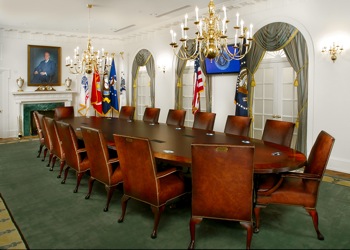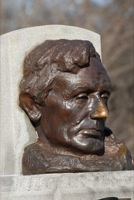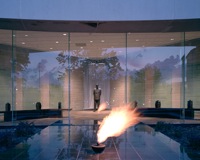
Courtesy Gerald Ford Museum
Take a walk through the streets of Springfield, Ill., and you’re following in the footsteps of history.
When he opened his Springfield law office in the 1840s, Abraham Lincoln wasn’t well known. But after his Civil War presidency, the Emancipation Proclamation and his assassination in Washington, Lincoln became revered as one of the most renowned leaders in American history, and the places he lived, worked and walked in Springfield have been preserved for generations.
The stories of our presidents have a way of captivating the American imagination, and in Springfield, as in many other places throughout the Midwest, visitors can retrace the lives of their presidential heroes. Whether it’s a president’s boyhood home, the front porch from which a president campaigned or a museum built after his time in office, “presidential” sites give us incredible perspective on the lives of the men who so profoundly shaped our country.
Lincoln is a favorite, but many other presidents also came from the Midwest, among them Harry Truman, Benjamin Harrison, Gerald Ford and Warren Harding. At the various sites associated with these men, groups will get a new appreciation for their lives and their careers of service.
Abraham Lincoln
Springfield, Ill.
In downtown Springfield, a number of buildings, including Lincoln’s home and office, have been set aside as the Lincoln Home National Historic Site, one of the most popular group tour stops in town.
 |
| Courtesy Springfield CVB |
“We take you into the Lincoln home, and you can walk where he walked,” said Kim Connor, group tour manager at the Springfield Convention and Visitors Bureau. “You can go into the law office where he practiced and then go into the Old State Capitol. You have a guided tour in each of those.”
This summer, visitors will get a more immersive look at Lincoln’s Springfield, with a living-history program downtown June 15 through Aug.15. The program features troubadour performances, costumed interpreters and Lincoln re-enactors in the streets of downtown.
Most groups visiting Springfield also tour the Abraham Lincoln Presidential Museum, a modern museum opened in 2005 that uses high-tech theaters, artifact exhibits and other displays to detail Lincoln’s life from his birth in Kentucky to his marriage to Mary Todd and his political career in Illinois.
“In the White House section, you see the elaborate gowns that Mary Todd wore and hear what the press was saying about Lincoln,” Connor said. “The most impacting part for me is the final part. They show [a replica of] the Ford Theater, and after his assassination, they show where his body lay in state at the Old State Capitol for 48 hours.”
Interested groups can also visit Lincoln’s tomb just outside of town, where the president is buried along with most members of his family.
www.visit-springfieldillinois.com
Benjamin Harrison Home
Indianapolis
Born and raised in Ohio, Benjamin Harrison and his wife, Caroline, moved to Indianapolis to open a law practice, and lived in three houses in the city before he ran for president. The third house, constructed in 1875, was intended to show off the success that Harrison had achieved as an attorney.
 |
| Courtesy Benjamin Harrison Home |
“It is Italianate, which was very popular during the Victorian time period,” said Phyllis Geeslin, executive director of the Benjamin Harrison Home. “Caroline died in the White House in 1892. When Benjamin came back to the house a widower, he added some things that he had enjoyed in the White House, like electricity and a wrap-around front porch.”
After Harrison’s death, family members preserved most of the furnishings that were used in the home. Today, about 80 percent of the furniture and decorations are original items that the president used. The staff has also gone to great lengths to reproduce the wallpaper and carpeting the Harrisons chose for the home.
On a tour, visitors can walk into nine rooms in the house and see some of the interesting items not often found in other historic homes.
“We have a number of political artifacts that are quite interesting and unusual,” Geeslin said. “We have Benjamin Harrison’s commission to brigadier general that was signed by Abraham Lincoln. It was a treasure to Harrison; he always liked to be called ‘General’ rather than ‘President.’”
www.presidentbenjaminharrison.org
Gerald R. Ford Museum
Grand Rapids, Mich.
Gerald Ford was never supposed to be president, but after Vice President Spiro Agnew resigned, Ford was nominated by President Richard Nixon. When Nixon also resigned, Ford found himself at the helm of the country in a very difficult time.
At the Gerald R. Ford Museum, exhibits deal with the political and cultural tumult of the 1970s.
“We have nine exhibit galleries that highlight the entire field of Ford’s life,” said Kristin Mooney, public affairs specialist at the museum. “We start out with a 1970s disco room to set the tone for our visitors. Then we go into the Watergate scandal, because this is where most Americans in the ’70s were introduced to Ford.”
The galleries introduce areas of Ford’s personal life, including his childhood in Michigan, along with information about his marriage to Betty Ford and her activities as first lady. Other exhibits deal with some of the major issues of Ford’s presidency, including his pardon of Nixon and his decision to pull American troops out of Vietnam.
To tell the story, the museum employees a number of special items and artifacts from Ford’s time in office.
“We have the original tools used in the Watergate break-in,” Mooney said. “We also have the stairs from the U.S. embassy in Saigon as well as a piece of the Berlin Wall. That’s a pretty big highlight.”
Warren G. Harding Home
Marion, Ohio
In 1891, Warren G. Harding built a home in Marion, Ohio, as a wedding gift for his fiance, Florence. The pair would live in the house for the next 30 years until Warren was elected president.
“It’s very much a small businessman’s home rather than a presidential home,” said Sherry Hall, interim site manager at the home. “They moved from the house in 1921 when they left for the White House. Since he died in office and she died a year later, they never went back to the house; so in many ways it stands still in time.”
Instead of traveling the country to campaign for the presidency, Harding conducted a famous “front porch campaign,” and visitors to the house can stand on the same porch where Harding addressed the thousands of visitors who came to hear him speak. Inside they can see many items that belonged to the Hardings. Some 95 percent of the items are original to the home.
“We have things arranged in the house as closely as possible to how the Hardings arranged it,” Hall said. “You’ll see furniture that they acquired during their lifetime and some of the presidential gifts, like a lot of unusual canes that people made themselves and sent to him.”
Highlights of the collection are a large humidor from the Cuban government, White House china and several pieces of Italian marble statuary that the Hardings brought back from a long vacation in Europe.
www.ohiohistory.org/place/harding
Harry S. Truman Presidential Library and Museum
Independence, Mo.
Harry Truman lived most of his adult life in Independence, Mo., leaving only during his political career in Washington. He returned to live in Independence after his time in the White House. Today, the Harry S. Truman Presidential Library and Museum details the president’s life in both Independence and Washington.
 |
| Courtesy Harry Truman Presidential Library |
“We have a gallery that we call the White House Gallery,” said Clay Bauske, the museum’s curator. “The centerpiece is a single exhibit case with the famous ‘The Buck Stops Here’ sign that he had on his desk as president. That’s sort of the overall theme of our permanent exhibits: the decision-making process and the fact that once the president makes decisions, he has to live with them.”
Displays in the museum deal with the many decisions Truman faced, from deploying the atomic bomb in Japan to firing Gen. Douglas MacArthur during the Korean War. In several “decision theaters” along the way, visitors can learn about the issues that confronted the president and then cast votes to reflect how they would have decided the issue.
On the lower level, the museum’s exhibit about the life and times of Harry Truman includes information on his childhood, his marriage and family, and the time he spent in Independence after his presidency. One of Truman’s personal automobiles is on display there, along with other artifacts from his private life.
In the museum’s courtyard, visitors can see the place where Truman and his wife are buried and can peek into the private office he kept at the library.
“You look into a window and see the office that Truman had in the building,” Bauske said. “He worked here almost every day from 1957 to the mid-1960s.”
More Midwest Travel Guide:
Midwest Capitols: The art of government
Midwest Water: A shore thing
Midwest Presidents: Hail to the chief
WEB EXCLUSIVE! Listing of Midwest Presidential Attractions










